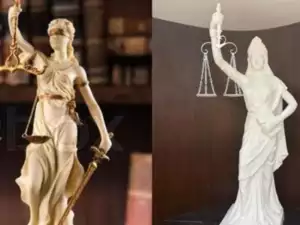
“Justice sees everyone equally”: Supreme Court unveils new ‘Lady Justice’ statue symbolising modern Indian legal ideals
A statue of a new justice deity who is not blindfolded and holds the constitution instead of a sword has been unveiled in the library dedicated to the study of justices in the Supreme premises. But the balance is retained and reflects impartiality.
NEW DELHI: The image of a blindfolded goddess of justice standing with a mace in her hand immediately comes to mind at court, but the image of this statue, which is said to be a symbol of justice, has now been redesigned.
CJI D.Y. Chandra chud said that the concept of GOD DESSOF JUSTICE statue was redesigned under Chandrachud’s leadership. There is now a need to move beyond the colonial legacy. Justice will be dispensed in India according to the Constitution. The intention behind the redesign of the Goddess of Justice statue is to convey the message that law is not blind, it is equal for all.
The familiar ‘Lady Justice’ statue, long associated with courts and legal institutions, has been redesigned by the Supreme Court of India as part of an effort to move away from its colonial legacy. Traditionally depicted with a blindfold and a sword, the statue’s updated version removes the blindfold and replaces the sword with the Constitution, signaling a new era for Indian justice.
Symbolic Change: Blindfold Removed
The statue of ‘Lady Justice,’ previously blindfolded to symbolize impartiality, has now had the blindfold removed in the Supreme Court’s updated version. The move was led by Chief Justice of India DY Chandrachud, who emphasized that “the law is not blind; it sees everyone equally.”
NNA sources, this change reflects the Indian judiciary’s evolving identity, one that no longer relies on colonial symbols to represent justice. The new statue, installed in the judges’ library, stands as a symbol of the judiciary’s commitment to this modern perspective.
The blindfold, traditionally meant to represent equality before the law and the idea that courts should be blind to wealth, power, or status, has been removed to align with a more contemporary interpretation of justice. CJI Chandrachud has made it clear that “justice sees everyone equally,” signaling that the judiciary’s role is not just about punishing but about upholding constitutional values that promote fairness and equality.
The unveiling of the redesigned statue signifies a larger shift in how the Indian judiciary sees its role in society. As a symbol, ‘Lady Justice’ no longer wears a blindfold but has her eyes open, reflecting the evolving perspective of the judiciary. With the Constitution in her hand, she represents a justice system that is no longer focused on punishment but rather on ensuring fairness and equality based on constitutional principles.
This move away from colonial symbols
New Era for Indian Justice
The unveiling of the redesigned statue signifies a larger shift in how the Indian judiciary sees its role in society. As a symbol, ‘Lady Justice’ no longer wears a blindfold but has her eyes open, reflecting the evolving perspective of the judiciary. With the Constitution in her hand, she represents a justice system that is no longer focused on punishment but rather on ensuring fairness and equality based on constitutional principles.
This move away from away from colonial symbols, spearheaded by CJI Chandrachud, highlights India’s continuing effort to embrace its own identity in the legal realm. As the country steps into a new era of justice, the redesigned ‘Lady Justice’ stands as a testament to the nation’s commitment to fairness, equality, and constitutional values.





